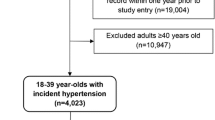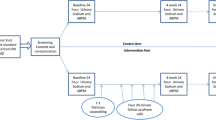Abstract
OBJECTIVE: To evaluate the prevalence of nutrition and exercise counseling for patients with hypertension.
DESIGN: Cross-sectional survey data from the National Ambulatory Medical Care Survey (NAMCS) and the National Hospital Ambulatory Medical Care Survey (NHAMCS) for 1999 and 2000.
SETTING: Office-based physician practices and hospital outpatient departments.
PATIENTS/PARTICIPANTS: Patients age 18 or older with a diagnosis of hypertension.
MEASUREMENTS AND MAIN RESULTS: In 1999 and 2000, over 137 million patient encounters had a diagnosis of hypertension. Nutrition and exercise counseling were provided at 35% and 26% of visits, respectively. Patients older than 74 received the least nutrition (28%) and exercise (18%) counseling. Asians and Hispanics were more likely to undergo any lifestyle counseling, while non-Hispanic whites received the least exercise and nutrition counseling. Patients with 2 cardiovascular comorbidities were counseled for diet (53%) and exercise (32%) more than those with 1 (44% and 31%) or none (30% and 23%; P≤.001 and P≤.001). The encounters in the NAMCS had higher rates of counseling than those in the NHAMCS. There were no significant differences in counseling rates with respect to gender, geographic region, severity of hypertension, or physician specialty.
CONCLUSIONS: While there were significant differences in counseling rates with respect to age, race, comorbidity, and survey cohort, counseling for therapeutic lifestyle changes for patients with hypertension was uniformly suboptimal. Physicians need to recognize the importance of nonpharmacologic treatment in hypertension.
Similar content being viewed by others
References
Anderson RN. Deaths: leading causes for 2000. Natl Vital Stat Rep. 2002;50:1–86.
Coresh J, Wei L, McQuillan G, et al. Prevalence of high blood pressure and elevated serum creatinine level in the United States: findings from the Third National Health and Nutrition Examination Survey (1988–1994). Arch Intern Med. 2001;161:1207–16.
World Health Report 2002: Reducing Risks, Promoting Healthy Life. Geneva Switzerland: World Health Organization; 2002. Available at: http//www.who.int/whr/2002. Accessed January 25, 2004.
The sixth report of the joint national committee on prevention, detection, evaluation, and treatment of high blood pressure. Arch Intern Med. 1997;157:2413–46.
Masuo K, Mikami H, Ogihara T, Tuck ML. Weight reduction and pharmacologic treatment in obese hypertensives. Am J Hypertens. 2001;14(6 pt 1):530–8.
He J, Whelton PK, Appel LJ, Charleston J, Klag MJ. Long-term effects of weight loss and dietary sodium reduction on incidence of hypertension. Hypertension. 2000;35:544–9.
Effects of weight loss and sodium reduction intervention on blood pressure and hypertension incidence in overweight people with high-normal blood pressure: the Trials of Hypertension Prevention, Phase II. The Trials of Hypertension Prevention Collaborative Research Group. Arch Intern Med. 1997;157:657–67.
Stevens VJ, Obarzanek E, Cook NR, et al. Trials for the Hypertension Prevention Research Group. Long-term weight loss and changes in blood pressure: results of the Trials of Hypertension Prevention, Phase II. Ann Intern Med. 2001;134:1–11.
Imai Y, Sato K, Abe K, et al. Effect of weight loss on blood pressure and drug consumption in normal weight patients. Hypertension. 1986;8:223–8.
Whelton PK, Appel LJ, Espeland MA, et al. Sodium reduction and weight loss in the treatment of hypertension in older persons: a randomized controlled trial of nonpharmacologic interventions in the elderly (TONE). TONE Collaborative Research Group. JAMA. 1998;279:839–46.
Sacks FM, Svetkey LP, Vollmer WM, et al. DASH-Sodium Collaborative Research Group. Effects on blood pressure of reduced dietary sodium and the Dietary Approaches to Stop Hypertension (DASH) diet. N Engl J Med. 2001;344:3–10.
Appel LJ, Espeland MA, Easter L, Wilson AC, Folmar S, Lacy CR. Effects of reduced sodium intake on hypertension control in older individuals: results from the Trial of Nonpharmacologic Interventions in the Elderly (TONE). Arch Intern Med. 2001;161:685–93.
Appel LJ, Moore TJ, Obarzanek E, et al. A clinical trial of the effects of dietary patterns on blood pressure. N Engl J Med. 1997;336:1117–24.
Appel LJ, Champagne CM, Harsha DW, et al. Writing Group of the PREMIER Collaborative Research Group. Effects of comprehensive lifestyle modification on blood pressure: results of the PREMIER clinical trial. JAMA. 2003;289:2083–93.
Xin X, He J, Frontini MG, Ogden LG, Motsamai OI, Whelton PK. Effects of alcohol reduction on blood pressure: a meta-analysis of randomized controlled trials. Hypertension. 2001;38:1112–7.
Puddey IB, Parker M, Beilin LJ, Vandongen R, Masarei JRL. Effects of alcohol and caloric restrictions on blood pressure and serum lipids in overweight men. Hypertension. 1992;20:533–41.
Whelton SP, Chin A, Xin X, He J. Effect of aerobic exercise on blood pressure: a meta-analysis of randomized, controlled trials. Ann Intern Med. 2002;136:493–503.
Chobanian AV, Bakris GL, Black HR, et al. National Heart, Lung, and Blood Institute Joint National Committee on Prevention, Detection, Evaluation, and Treatment of High Blood Pressure; National High Blood Pressure Education Program Coordinating Committee. Seventh report of the Joint National Committee on Prevention, Detection, Evaluation, and Treatment of High Blood Pressure. Hypertension. 2003;42:1206–52.
Pearson TA, Blair SN, Daniels SR, et al. AHA Guidelines for Primary Prevention of Cardiovascular Disease and Stroke: 2002 update: consensus panel guide to comprehensive risk reduction for adult patients without coronary or other atherosclerotic vascular disease. American Heart Association Science Advisory and Coordinating Committee. Circulation. 2002;106:388–91.
World Health Organization, International Society of Hypertension Writing Group. 2003 World Health Organization (WHO)/International Society of Hypertension (ISH) statement on management of hypertension. J Hypertens. 2003;21:1983–92.
Wee CC, McCarthy EP, Davis RB, Phillips RS. Physician counseling about exercise. JAMA. 1999;282:1583–8.
Giles W. Missed opportunities in preventive counseling for cardiovascular disease: United States, 1995. MMWR 1998;47:91–5.
Egede LE, Zheng D. Modifiable cardiovascular risk factors in adults with diabetes: prevalence and missed opportunities for physician counseling. Arch Intern Med. 2002;162:427–33.
Meigs JB, Stafford RS. Cardiovascular disease prevention practices by U.S. physicians for patients with diabetes. J Gen Intern Med. 2000;15:220–8.
Stafford RS, Blumenthal D, Pasternak RC. Variations in cholesterol management practices of U.S. physicians. J Am Coll Cardiol. 1997;29:139–46.
Stafford RS, Farhat JH, Misra B, Schoenfeld DA. National patterns of physician activities related to obesity management. Arch Fam Med. 2000;9:631–8.
Desai MM, Rosenheck RA, Druss BG, Perlin JB. Receipt of nutrition and exercise counseling among medical outpatients with psychiatric and substance use disorders. J Gen Intern Med. 2002;17:556–60.
National Center for Health Statistics. Ambulatory Health Care Data: Survey Methodology. Available at: http://www.cdc.gov/nchs/about/major/ahcd/ahcd1.htm. Accessed September 30, 2003.
Burt CW. Use of geographic contextual variables in examining survey item validity. Seventh Conference on Health Survey Research Methods. September 24–27, 1999. Available at: http://www.cdc.gov/nchs/data/conf/conf07.pdf. Accessed January 10, 2004.
Cooper R, Rotimi C. Hypertension in blacks. Am J Hypertens. 1997;10(7 pt 1):804–12.
Crespo CJ, Loria CM, Burt VL. Hypertension and other cardiovascular disease risk factors among Mexican Americans, Cuban Americans, and Puerto Ricans from the Hispanic Health and Nutrition Examination Survey. Public Health Rep. 1996;111(suppl 2):7–10.
Pahor M, Applegate WB. Recent advances. Geriatric medicine. BMJ. 1997;315:1071–4.
Flegal KM, Carroll MD, Ogden CL, Johnson CL. Prevalence and trends in obesity among US adults, 1999–2000. JAMA. 2002;288:1723–7.
Ly N, McCraig L, Burt CW. National Hospital Ambulatory Medical Care Survey: 1999 outpatient department summary. Adv Data Vital Health Stat. 2001;321:1–28.
Cherry DK, Woodwell DA. National Medical Care Survey: 2000 summary. Adv Data Vital Health Stat. 2002;328:1–32.
Rogers LQ, Bailey JE, Gutin B, et al. Teaching resident physicians to provide exercise counseling: a needs assessment. Acad Med. 2002;77:841–4.
Expert Panel on Detection, Evaluation, and Treatment of High Blood Cholesterol in Adults. Executive Summary of the Third Report of the National Cholesterol Education Program (NCEP) Expert Panel on Detection, Evaluation, and Treatment of High Blood Cholesterol in Adults (Adult Treatment Panel III). JAMA. 2001;285:2486–97.
Kushner RF. Barriers to providing nutrition counseling by physicians: a survey of primary care practitioners. Prev Med. 1995;24:546–52.
Orleans CT, George LK, Houpt JL, Brodie KH. Health promotion in primary care: a survey of U.S. family practitioners. Prev Med. 1985;14:636–47.
Yeager KK, Donehoo RS, Macera CA, Croft JB, Heath GW, Lane MJ. Health promotion practice among physicians. Am J Prev Med. 1996;12:238–41.
Sherman SE, Hershman WY. Exercise counseling: how do general internists do? J Gen Intern Med. 1993;8:243–8.
U.S. Preventive Services Task Force. Behavioral counseling in primary care to promote a healthy diet. Am J Prev Med. 2003;24:93–100.
Prochaska JO, Velicer WF. The transtheoretical model of health behavior change. Am J Health Promot. 1997;12:38–48.
Mann J. Importance of dietary management and practical patient counseling, the European/Australasian perspective. Atheroscler Suppl. 2002;3:23–9.
Calfas KJ, Long BJ, Sallis JF, Wooten WJ, Pratt M, Patrick K. A controlled trial of physician counseling to promote the adoption of physical activity. Prev Med. 1996;25:225–33.
Miller WR. Motivational interviewing: research, practice, and puzzles. Addict Behav. 1996;21:835–42.
Emmons KM, Rollnick S. Motivational interviewing in health care settings. Opportunities and limitations. Am J Prev Med. 2001;20:68–74.
Stange KC, Zyzanski SJ, Smith TF, et al. How valid are medical records and patient questionnaires for physician profiling and health services research? A comparison with direct observation of patient visits. Med Care. 1998;36:851–67.
Nielsen SJ, Popkin BM. Patterns and trends in food portion sizes, 1977–1998. JAMA. 2003;289:450–3.
Whelton PK, He J, Appel LJ, et al. National High Blood Pressure Education Program Coordinating Committee. Primary prevention of hypertension: clinical and public health advisory from the National High Blood Pressure Education Program. JAMA. 2002;288:1882–8.
Author information
Authors and Affiliations
Corresponding author
Rights and permissions
About this article
Cite this article
Mellen, P.B., Palla, S.L., Goff, D.C. et al. Prevalence of nutrition and exercise counseling for patients with hypertension. J GEN INTERN MED 19, 917–924 (2004). https://doi.org/10.1111/j.1525-1497.2004.30355.x
Issue Date:
DOI: https://doi.org/10.1111/j.1525-1497.2004.30355.x




